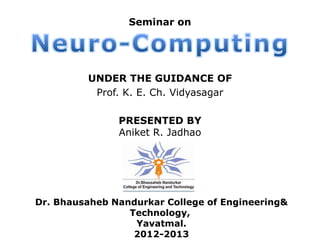
Seminar Neuro-computing
- 1. Seminar on UNDER THE GUIDANCE OF Prof. K. E. Ch. Vidyasagar PRESENTED BY Aniket R. Jadhao Dr. Bhausaheb Nandurkar College of Engineering& Technology, Yavatmal. 2012-2013
- 2. Contents Introduction Characteristics of ANN Biological neural networks Backpropogation Algorithm Advantages Applications Conclusion References
- 3. Introduction Neurocomputing is concerned with information processing A neurocomputing approach to information processing first involves a learning process within a neural network architecture that adaptively responds to inputs according to a learning rule
- 4. Cont... After the neural network has learned what it needs to know , the trained network can be used to perform certain tasks depending on a particular application Neural networks have the capability to learn from their environment and to adapt to it in an interactive manner.
- 5. What do you think which is faster? OR A DIGITAL COMPUTER A HUMAN BEING?
- 6. Here come to answer ... A human being is faster than Digital computer. But why ? How can we perform certain tasks better and faster than a digital computer? Do you know ? Difference between brain and a digital computer?
- 7. Cont.. Neuron Neurons are approximately six orders of magnitude slower than silicon logic gates, However the brain can compensate for the relatively slow operational speed of the neuron by processing data in a highly parallel architecture that is massively interconnected. It is estimated that the human brain must contain in the order of 10 raise to power 11 neurons and approximately three orders of magnitude more connections or synapses Therefore, the BRAIN is an adaptive, nonlinear, parallel computer that is capable of organizing neurons to perform certain tasks
- 9. Cont... Characteristics of ARTIFICIAL NEURAL NETWORKS Ability to learn by example, An ARTIFICIAL NEURAL NETWORK stores the knowledge that has been learned during the training process in the synaptic weights of neurons Ability to generalise
- 10. BACK-PROPAGATION ALGORITHIM Figure 5: Backpropagation Training
- 11. Advantages of neurocomputing approach to solving certain problems Adaptive learning: An ability to learn how to do tasks based on the data. Self-Organization: An ANN can create its own organization Real Time Operation: ANN computations may be carried out in parallel and special hardware devices are being designed and manufactured which take advantage of this capability Fault Tolerance via Redundant Information Coding: Partial destruction of a network leads to the corresponding degradation of performance
- 12. Applications Voice Recognition - Transcribing spoken words into ASCII text Target Recognition - Military application which uses video and/or infrared image data to determine if an enemy target is present Medical Diagnosis - Assisting doctors with their diagnosis by analyzing the reported symptoms and/or image data such as MRIs or X-rays Radar –signature classifier
- 13. Conclusion Then the network is followed by the error generator at the output, which compares the output of the neuron with the target signal for which the network has to be trained. Similarly, there is error generator at the input, which updates the weights of the first layer taking into account the error propagated back from the output layer. Finally, a weight transfer unit is present just to pass on the values of the updated weights to the actual weights.
- 14. REFERNACES [1] Simon Haykin, “Neural Networks”, Second edition by, Prentice Hall of India, 2005. [2] Christos Stergiou and Dimitrios Siganos, “Neural Networks”, Computer Science Deptt. University of U.K., Journal, Vol. 4, 1996. [3] Robert J Schalkoff, “Artificial Neural Networks”, McGraw-Hill International Editions, 1997. [4] Uthayakumar Gevaran, “Back Propagation”, Brandeis University, Department of Computer Science. [5] Jordan B.Pollack, “Connectionism: Past, Present and Future”, Computer and Information Science Department, The Ohio State University, 1998.
- 15. So, we can see that how neural networks and neurocomputing is beneficial for us. Thank you ! Instead of seeing society as a collection of clearly defined “interest groups”, society must be reconceptualise as a complex network of groups of interacting individuals whose membership and communication pattern are seldom confined to one such group alone
